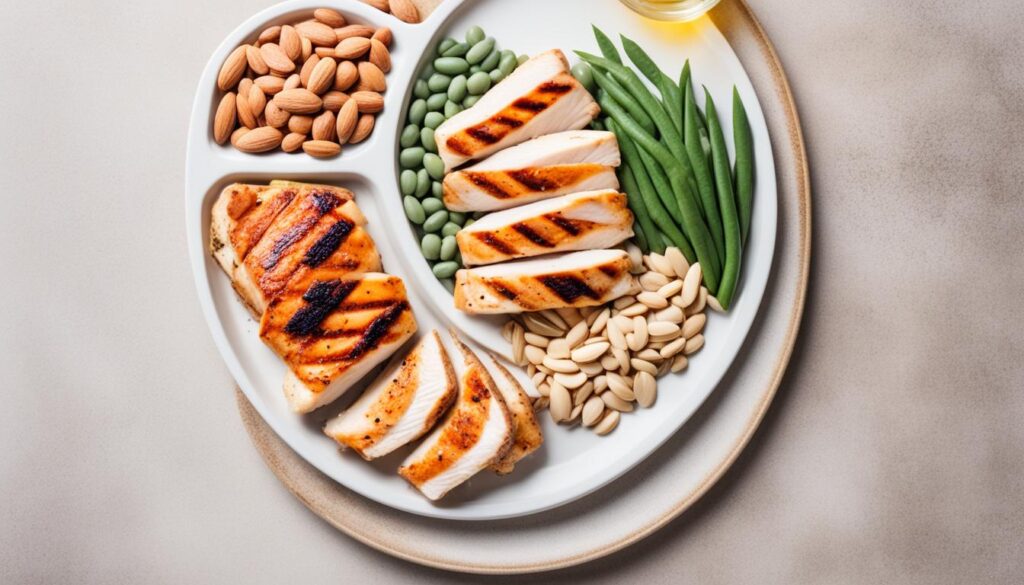Have you been diligently following a healthy diet and exercise routine, only to find the scale stubbornly refusing to budge? You’re not alone1. Most people experience a weight loss plateau at some point during their weight loss journey despite continued healthy eating and regular exercise. But fear not – there are proven strategies to help you break through that frustrating plateau and get your weight loss back on track.
In this article, we’ll dive into the science behind weight loss plateaus and share expert-backed tips to help you overcome them. From adjusting your macros to amping up your activity levels, we’ll equip you with the knowledge and tools you need to conquer that stubborn plateau and reach your health and fitness goals.
Key Takeaways
- Weight loss plateaus are a normal part of the journey and happen to most people.
- Understanding the causes of plateaus, like glycogen depletion and muscle loss, can help you address them.
- Strategies like cutting carbs, increasing exercise, and boosting protein intake can help restart weight loss.
- Tracking your food intake, managing stress, and getting enough sleep are also crucial for breaking through a plateau.
- Patience and persistence are key – it may take time to find the right combination of tactics to get your weight loss moving again.
What is a Weight Loss Plateau?
A weight loss plateau is a common phenomenon that occurs when your weight stops changing, despite maintaining your diet and exercise routine. This happens because your body has adjusted to the calorie deficit, and your metabolism has slowed down to adapt to the reduced calorie intake2. As you lose weight, your body requires fewer calories to function, making it harder to continue losing weight at the same rate. This is known as a weight loss stall, and it’s a frustrating experience that many people face during their weight loss journey.
Understanding the Weight Loss Stall
When you lose weight, your metabolism slows down because your body doesn’t require the same level of energy to maintain your size2. This is a natural physiological response, as your body tries to conserve energy and prevent further weight loss2. Additionally, research shows that two-thirds of people regain all the weight they lost, and then some, after following a strict diet3. This is because weight-loss plateaus can last as long as eight to twelve weeks3, and the body’s set-point range can be as high as 5-10% of their body weight3.
Weight loss plateaus can be demotivating and frustrating for individuals on a weight loss journey3. However, it’s important to understand that these plateaus are essential for the body to readjust and reset, especially after reaching the set-point weight3. If weight is lost slowly and gradually, the body’s set point can adjust, making it easier to maintain weight loss in the long run3.
Incorporating more movement throughout your day can keep your metabolism up, aiding in weight loss2. Consistency in the gym is also essential when trying to lose the last bit of weight2. Skipping just one workout can lead to an increased likelihood of missing another one by 61 percent, according to British research2.
In summary, a weight loss plateau is a natural physiological response to weight loss, and understanding the causes behind it can help you overcome this challenge and continue your journey towards a healthier, happier you243.
Causes of Weight Loss Plateaus
Achieving and maintaining weight loss can be a challenging journey, with many individuals facing frustrating weight loss plateaus along the way. These plateaus can be caused by a variety of factors, from depletion of glycogen stores to metabolic adaptations. Understanding the underlying reasons for these weight loss stalls is crucial for overcoming them and getting back on track with your fitness goals5.
Glycogen Depletion and Muscle Loss
One common cause of a weight loss plateau is the depletion of glycogen stores in the muscles and liver. As you lose weight, your body may release water that was previously stored with glycogen, leading to a temporary drop in the number on the scale5. Additionally, as you continue to lose weight, you may also experience a loss of muscle mass, which can lower your overall metabolic rate and make it more challenging to continue losing weight at the same pace5.
Metabolic Adaptation
Another factor that can contribute to a weight loss plateau is metabolic adaptation. As you reduce your calorie intake and lose weight, your body may adjust by slowing down its metabolic rate, making it more difficult to continue losing weight at the same rate5. This adaptation is a natural defense mechanism to prevent further weight loss, as the body tries to conserve energy and maintain its current state6.
Factors such as hormonal changes, increased hunger levels, and a lower non-exercise activity thermogenesis (NEAT) can all play a role in this metabolic adaptation process57. Understanding these metabolic changes is crucial for adjusting your weight loss strategy and overcoming plateaus.
| Reason | Description |
|---|---|
| Glycogen Depletion | As you lose weight, your body may release water that was previously stored with glycogen, leading to a temporary drop in the number on the scale. |
| Muscle Loss | Losing weight can also result in a loss of muscle mass, which can lower your overall metabolic rate and make it more challenging to continue losing weight. |
| Metabolic Adaptation | Your body may slow down its metabolic rate as a defense mechanism to prevent further weight loss, making it more difficult to continue losing weight at the same rate. |
By understanding these common causes of weight loss plateaus, individuals can adjust their strategies and make informed decisions to overcome these challenges and continue their weight loss journey successfully.
Cut Back on Carbs
Reducing your carbohydrate intake may be an effective way to help break through a weight loss plateau. A low-carb diet for weight loss has been shown to help reduce hunger and promote fat loss, potentially giving your weight loss efforts a much-needed boost8. By cutting back on carbs and focusing on nutrient-dense, high-protein and high-fiber foods, you can help your body switch to burning fat for fuel, leading to continued weight loss8.
On a standard keto diet, one should only consume 20–50 grams of carbs per day9. Too many carbs can lead to a weight loss plateau on a low-carb or ketogenic diet8. Sources of overconsumption include starchy side dishes, sugary desserts, low-carb alternatives, and hidden carbs in condiments8.
Adjusting your protein intake and tracking your protein consumption can also help avoid a weight loss plateau from too much protein8. Additionally, monitoring and adjusting your fat intake, including assessing added fats to meals and beverages, can prevent a weight loss plateau from too much fat8.
By reducing carbs to break a plateau, focusing on nutrient-dense foods, and carefully managing your macronutrient intake, you can unlock the benefits of carb restriction and get your weight loss back on track8.
“Carla lost 20 pounds in three months before hitting a weight loss plateau. Carla broke through the plateau by incorporating strength training and increasing the intensity of her cardio workouts. Carla lost two pounds after making changes to her routine. Carla lost another five pounds over the next few weeks by adding more protein, cutting back on carbs, and including yoga and meditation.”10
Remember, weight loss is a journey that takes time to achieve your goals10. By making strategic adjustments to your diet and exercise routine, you can overcome weight loss plateaus and continue making progress towards your desired outcomes.
Increase Exercise Frequency or Intensity
Overcoming a weight loss plateau often requires a strategic approach to exercise. Increasing the frequency or intensity of your workouts can be a powerful way to reignite your weight loss journey11. Research suggests that a combination of aerobic and resistance training is most effective for continued weight loss, as it helps to maintain or even increase your muscle mass while burning more calories11.
Combining Aerobic and Resistance Training
When it comes to breaking through a weight loss plateau, incorporating both aerobic and resistance training exercises can be a game-changer. Aerobic activities, such as running, cycling, or swimming, help to burn calories and improve cardiovascular health, while resistance training, like weightlifting or bodyweight exercises, helps to build and maintain muscle mass11. This synergistic approach not only boosts your overall calorie expenditure but also ensures that you’re preserving lean muscle tissue, which is crucial for maintaining a healthy metabolism11.
Boosting Non-Exercise Activity Thermogenesis (NEAT)
In addition to structured exercise, increasing your non-exercise activity thermogenesis (NEAT) can also be an effective way to overcome a weight loss plateau. NEAT refers to the energy expenditure from all physical activities that are not part of your formal exercise routine, such as fidgeting, standing, or simply moving around more throughout the day11. By finding ways to boost your NEAT, you can increase your overall calorie burn and help break through that stubborn plateau11.
Remember, the key to overcoming a weight loss plateau is to continuously challenge your body and keep your metabolism guessing. Experiment with different exercise modalities, adjust your workout frequency and intensity, and find ways to increase your overall daily movement11. With persistence and a willingness to adapt, you can overcome any weight loss plateau and achieve your desired results11.

“The secret to breaking through a weight loss plateau is to constantly evolve your fitness routine and challenge your body in new ways. It’s all about keeping your metabolism on its toes.”
Track Everything You Eat
Closely monitoring your food intake can be a critical step in overcoming a weight loss plateau. Many people tend to underestimate the number of calories they consume, which can lead to a calorie surplus and stall their progress12. By using a food tracking app or website to record your calorie and macronutrient intake, you can gain a better understanding of your daily consumption and make necessary adjustments to continue losing weight13.
Tracking everything you eat, including portion sizes, hidden sugars, and high-calorie condiments, can help you avoid consuming more calories than intended12. Research suggests that individuals often don’t realize the actual amount of calories they consume, which can contribute to weight loss plateaus13.
Using a food diary or app can help uncover these unnoticed extra calories in your diet12. Studies have shown that participants become more aware of their caloric intake when tracking their food intake through a journal, indicating an underestimation of their consumption13.
Closely monitoring your food intake can also provide valuable insights into the types of foods and macronutrient ratios that work best for your body. By adjusting your diet based on this information, you can break through a weight loss plateau and continue your progress towards a healthier weight12.
“Closely tracking everything you eat can be a game-changer in overcoming a weight loss plateau. It’s like shining a light on the hidden culprits that might be sabotaging your efforts.”
In addition to using a food tracking app or diary, you can also consider other tools to help monitor your nutrition. This may include things like using a kitchen scale to measure portion sizes, reading nutrition labels carefully, and keeping a close eye on your macronutrient intake12.
Remember, the importance of food tracking goes beyond just weight loss. It can also provide valuable insights into your overall health and well-being, helping you make more informed decisions about your diet and lifestyle131214.
Don’t Skimp on Protein
Ensuring that you’re consuming an adequate amount of protein is essential for overcoming a weight loss plateau. Protein has a higher thermic effect compared to carbs and fat, meaning it requires more energy for your body to digest and metabolize15. Additionally, protein can help suppress appetite and keep you feeling full, which can prevent overeating and support continued weight loss15. Incorporating more lean protein sources into your diet can be a valuable strategy for breaking through a weight loss plateau.
Protein’s Thermic Effect and Appetite-Suppressing Abilities
The thermic effect of food refers to the energy your body expends to digest, absorb, and metabolize the nutrients you consume. Protein has a higher thermic effect compared to carbohydrates and fats, which means your body burns more calories to process protein16. This can contribute to a slight increase in your metabolic rate, potentially aiding in your weight loss efforts.
Moreover, protein’s appetite-suppressing abilities can play a crucial role in overcoming a weight loss plateau. Protein-rich foods tend to keep you feeling fuller for longer, reducing the likelihood of snacking or overeating15. By incorporating more protein into your diet, you can better manage your hunger and cravings, making it easier to stick to your weight loss plan.
| Nutrient | Thermic Effect |
|---|---|
| Protein | 20-30% of calories |
| Carbohydrates | 5-10% of calories |
| Fats | 0-3% of calories |
The table above illustrates the varying thermic effects of different macronutrients, highlighting the higher energy expenditure associated with the digestion and metabolism of protein16. By prioritizing protein-rich foods, you can leverage this thermal effect to support your weight loss goals.

Remember, the key to overcoming a weight loss plateau is to find strategies that work for your individual needs and preferences. Incorporating more protein-rich foods, such as lean meats, eggs, dairy, legumes, and plant-based options, can be a simple yet effective way to boost your metabolism and suppress your appetite, ultimately helping you break through that stubborn weight loss plateau151716.
Manage Stress
Stress can be a significant obstacle in the journey towards weight loss. When we experience stress, our bodies release cortisol, a hormone that can promote fat storage and make it more challenging to shed unwanted pounds18. Addressing stress should be an integral part of any comprehensive weight loss strategy.
To manage stress and create a more favorable environment for weight loss, consider incorporating the following techniques into your routine:
- Meditation and Mindfulness: Practices like meditation and mindfulness can help regulate cortisol levels, reduce anxiety, and promote a sense of calm19.
- Yoga and Deep Breathing: Engaging in gentle yoga or deep breathing exercises can lower stress and promote relaxation18.
- Regular Exercise: Physical activity not only burns calories but also releases endorphins, which can improve mood and manage stress19.
- Adequate Sleep: Prioritizing quality sleep is crucial for weight loss, as poor sleep can disrupt hunger and satiety hormones1920.
- Journaling and Counseling: Writing down your thoughts and feelings or seeking support from a mental health professional can help manage stress and provide a healthy outlet19.
By incorporating stress management techniques into your weight loss plan, you can create a more conducive environment for your body to shed unwanted pounds and achieve your goals18. Remember, managing stress is not just about weight loss; it’s also crucial for your overall health and well-being.
“The greatest weapon against stress is our ability to choose one thought over another.” – William James
Embracing stress management as part of your weight loss journey can help you break through plateaus, maintain motivation, and ultimately achieve lasting results19. By prioritizing self-care and finding healthy ways to cope with stress, you can take a significant step towards a healthier, happier you.
Try Intermittent Fasting
Implementing an intermittent fasting (IF) regimen may be a helpful strategy for breaking through a weight loss plateau21. Intermittent fasting involves cycling between periods of eating and fasting, which can help to boost fat burning, increase insulin sensitivity, and promote weight loss21. There are several different methods of intermittent fasting, such as the 16:8 or 24-hour fasting approaches, and trying one of these may help to kick-start your weight loss again21.
Fasting is a stress applied to the body that leads to adaptation over time21. Plateaus in weight loss occur when the body has adapted to a particular change before reaching the overall goal21. Consistent intermittent fasting (IF) combined with resistance training can improve muscle mass, insulin sensitivity, and burn more body fat21.
However, it’s important to note that some practices like adding cream to coffee or taking branch chain amino acids (BCAAs) can trigger an insulin response, disrupting the fasting state21. To maximize the benefits of intermittent fasting, it’s crucial to adhere to the fasting periods and avoid any caloric intake during that time21.
“Fasting is a stress applied to the body that leads to adaptation over time.”
Implementing an intermittent fasting approach may help you overcome a weight loss plateau. By cycling between periods of fasting and eating, you can boost fat burning, increase insulin sensitivity, and promote further weight loss21. Just be mindful of any practices that could disrupt the fasting state, and focus on staying true to the fasting periods to maximize the benefits21.

Avoid Alcohol
If you’ve hit a weight loss plateau, it may be beneficial to reduce or eliminate alcohol from your diet. Alcohol can be a significant obstacle to weight loss as it provides empty calories without any nutritional value22. Moreover, alcohol can impair judgment and lead to increased food intake, further sabotaging your weight loss efforts22.
Consuming alcohol can have a negative impact on your metabolism. Alcohol is metabolized as a priority by the liver, which means that fat burning is put on hold while the body processes the alcohol22. This can slow down your weight loss progress and contribute to the dreaded plateau. To overcome a weight-loss plateau, it is advised to cut calorie intake further and/or burn more calories through exercise23.
- Alcohol contains 7 calories per gram, making it a high-calorie beverage that can easily sabotage your weight loss efforts22.
- Consuming alcohol can also lead to increased hunger and cravings for high-calorie, unhealthy foods, further hindering your weight loss journey22.
- By eliminating or significantly reducing your alcohol intake, you can boost your metabolism, reduce calorie intake, and support continued weight loss22.
To break through a weight-loss plateau, individuals are advised to engage in at least 90 minutes of cardiovascular exercise most days of the week23. Additionally, it is recommended to include strength (resistance) training at least 2 to 3 times per week to maintain and increase muscle mass, which leads to a higher metabolic rate and more calories burned even at rest23.
By avoiding alcohol and focusing on a well-rounded exercise routine, you can overcome your weight loss plateau and continue your journey towards a healthier, fitter you. Remember, small changes in your lifestyle can make a big difference in your weight loss success22723.
Eat More Fiber
When it comes to overcoming weight loss plateaus, increasing your fiber intake, particularly soluble fiber, can be a highly effective strategy. Soluble fiber can help slow the digestion of food, leading to increased feelings of fullness and satisfaction24. This can, in turn, reduce calorie intake and support continued weight loss. Additionally, fiber may help decrease the number of calories absorbed from other foods, further contributing to weight loss efforts24.
Soluble Fiber’s Benefits for Weight Loss
Soluble fiber, such as that found in oats, beans, lentils, and avocados, can be particularly beneficial for weight loss. These fiber-rich foods can help you feel fuller for longer, reducing the likelihood of overeating and snacking throughout the day24. Consuming high-fiber foods can also aid in regulating blood sugar levels, which can help prevent sudden spikes and crashes that can lead to cravings and uncontrolled eating24.
Incorporating more soluble fiber into your diet can be a game-changer for breaking through a weight loss plateau24. By slowing the digestion of food and promoting a sense of satiety, soluble fiber can contribute to an overall reduction in calorie intake, ultimately supporting your weight loss goals24.
| High-Fiber Foods for Weight Loss | Fiber Content (per serving) |
|---|---|
| Lentils (1 cup cooked) | 15.6 grams |
| Raspberries (1 cup) | 8 grams |
| Avocado (1 medium) | 10 grams |
| Oats (1 cup cooked) | 4 grams |
| Broccoli (1 cup cooked) | 5.1 grams |
By incorporating more of these high-fiber foods into your meals and snacks, you can help support your weight loss efforts and overcome any plateaus you may be experiencing24.
“Fiber is essential for weight management, as it helps you feel fuller for longer, regulates blood sugar levels, and may even reduce the number of calories absorbed from other foods.”
Remember, a balanced approach to nutrition, exercise, and lifestyle modifications is key to achieving sustainable weight loss24. By focusing on increasing your fiber intake, particularly soluble fiber, you can empower your body to break through weight loss plateaus and continue your journey towards a healthier, more vibrant you24.
Drink Water, Coffee, or Tea
Staying hydrated and consuming beverages that may boost metabolism can be beneficial for overcoming a weight loss plateau. Drinking water, especially before meals, can help to promote feelings of fullness and increase your metabolic25. Similarly, consuming caffeine-containing beverages like coffee or tea may provide a metabolic boost and enhance the fat-burning effects of exercise2526.,
Prioritizing hydration and incorporating these beverages into your daily routine can support your weight loss efforts. Studies have shown that water, tea, and coffee can aid in weight loss by improving digestion, increasing feelings of fullness, and boosting metabolic rate by up to26. Additionally, green tea’s antioxidant EGCG has been found to enhance fat burning26.
- Drinking water, especially before meals, can help promote feelings of fullness and increase metabolic rate2526.,
- Consuming caffeine-containing beverages like coffee or tea may provide a metabolic boost and enhance the fat-burning effects of exercise2526.,
- Green tea’s antioxidant EGCG has been found to enhance fat burning26.
“Staying hydrated and consuming beverages that may boost metabolism can be beneficial for overcoming a weight loss plateau.”
By prioritizing hydration and incorporating these beverages into your daily routine, you can support your weight loss efforts and help overcome any plateaus you may face. Consistent hydration and the strategic use of caffeinated drinks can be powerful tools in your weight loss27.
Get Plenty of Sleep
Quality sleep is crucial for successful weight loss, and a lack of it can contribute to a weight loss plateau28. An average adult needs around seven to eight hours of sleep on most nights, and at least eight hours of uninterrupted sleep every night is recommended to overcome weight loss plateaus28. When you don’t get enough sleep, your body’s hormones that regulate appetite and metabolism can become imbalanced, leading to increased hunger, reduced energy expenditure, and difficulty losing weight29.
Sleep apnea and hypopnea often go undiagnosed, even in mild cases, causing significant health issues28. Sleep apnea leads to our blood oxygen levels going below 90% at least five times a night28. Continuous positive airway pressure (CPAP) devices are considered the “gold standard” treatment for sleep apnea and weight loss28. Research suggests that cognitive behavioral therapy for insomnia is an effective treatment for sleep-related challenges28.
Establishing a consistent sleep routine and practicing good sleep hygiene are key to improving sleep quality and overcoming weight loss plateaus28. This includes not using electronic devices at bedtime, maintaining a comfortable temperature in the bedroom, and avoiding bright lights and noise28. Exercise daily, practice mindfulness, create a relaxing environment, and focus on the positive to further enhance sleep quality and support your weight loss goals28. Avoid sweet snacks or heavy meals within three hours of bedtime to ensure better sleep28.
Keeping a sleep and weight journal can help you track your progress and troubleshoot any sleep-related issues28. By prioritizing quality sleep, you’ll be better equipped to overcome weight loss plateaus and achieve your desired results28.
“Adequate sleep is crucial for successful weight loss, and a lack of sleep can contribute to a weight loss plateau.”
Eat Vegetables at Every Meal
Incorporating a variety of vegetables into your meals is a simple yet effective strategy for overcoming a weight loss plateau30. Vegetables are typically low in calories, high in fiber, and packed with essential nutrients, making them an ideal food choice for weight loss30. Eating vegetables at every meal can help you feel full and satisfied, while also providing your body with the essential nutrients it needs to function optimally and support your weight loss efforts.
One of the key benefits of incorporating vegetables into your meals is their high-volume, low-calorie nature31. Recommendations include aiming to fill half of lunch and dinner plates with non-starchy vegetables, a quarter with lean protein, and a quarter with healthy carbohydrates31. By prioritizing these nutrient-dense, high-volume foods, you can effectively manage your calorie intake and overcome a weight loss plateau.
Furthermore, the fiber content in vegetables can play a crucial role in maintaining weight loss32. Consuming at least 30 grams of fiber daily from sources like oatmeal, nuts, berries, beans, and apples can aid in weight loss plateau breakthroughs32. The fiber in vegetables helps to promote feelings of fullness, regulate digestion, and support overall metabolic health.
To maximize the benefits of incorporating vegetables into your meals, consider the following tips:
- Aim to include a variety of colorful vegetables in your meals, as each type offers unique nutritional benefits.
- Experiment with different cooking methods, such as roasting, steaming, or sautéing, to keep your vegetable dishes flavorful and appealing.
- Incorporate vegetables into your snacks as well, such as carrot sticks or cucumber slices with a healthy dip.
- Use vegetables as the base for your meals, such as a leafy green salad or a veggie-packed stir-fry.
By making vegetables a consistent part of your meals, you can unlock the benefits of vegetables for weight loss, support your high-volume low-calorie foods strategy, and cultivate a nutrient-dense vegetables for weight management approach to your overall health and wellness303132.
“Incorporating a variety of vegetables into your meals can be a simple yet effective strategy for overcoming a weight loss plateau.”
Don’t Rely on the Scale Alone
While the scale can provide an important data point, it’s crucial not to solely focus on the number it displays when tracking your weight loss progress33. During weight loss journeys, plateaus are a common occurrence experienced by individuals, impacting their progress and causing feelings of being stuck or stagnant34. A weight loss plateau typically occurs after an initial period of rapid weight loss, where progress slows down suddenly.
The scale may not accurately reflect the changes happening in your body composition35. As you lose fat and gain muscle, the scale may not move, or it may even show a slight increase, even though you’re losing inches and improving your overall body shape. Instead, consider using other methods to track your progress, such as measuring your waist circumference, monitoring how your clothes fit, and paying attention to how you feel physically and mentally.
34 Weight loss plateaus are common during a weight loss journey, affecting nearly everyone at some point35. Hormonal changes occur during weight loss, with increases in ghrelin (hunger hormone) and decreases in leptin (feeling full hormone), which can contribute to the plateau. By focusing on progress beyond the scale, you can stay motivated and make sustainable changes that lead to long-term success.
FAQ
What is a weight loss plateau?
A weight loss plateau is when your weight stops changing, despite maintaining your diet and exercise routine. This can happen because your body has adjusted to the calorie deficit and your metabolism has slowed down to adapt to the reduced calorie intake.
What are the main causes of a weight loss plateau?
The main causes of a weight loss plateau include glycogen depletion and muscle loss, as well as metabolic adaptation, where your body adjusts to the reduced calorie intake by slowing down its metabolic rate.
How can reducing carbohydrates help break through a weight loss plateau?
Reducing your carbohydrate intake may be an effective way to help break through a weight loss plateau. Carb restriction has been shown to help reduce hunger and promote fat loss, potentially giving your weight loss efforts a much-needed boost.
How can increasing exercise frequency or intensity help overcome a weight loss plateau?
Increasing the frequency or intensity of your exercise routine can be a powerful way to overcome a weight loss plateau. Research suggests that a combination of aerobic and resistance training is most effective for continued weight loss, as it helps to maintain or even increase your muscle mass while burning more calories.
Why is closely tracking your food intake important for breaking through a weight loss plateau?
Closely tracking everything you eat can be a critical step in breaking through a weight loss plateau. Many people tend to underestimate the amount of food they consume, which can lead to a calorie surplus and stall weight loss. By using a food tracking app or website, you can gain a better understanding of your daily consumption and make necessary adjustments to continue losing weight.
How can increasing your protein intake help overcome a weight loss plateau?
Ensuring that you’re consuming an adequate amount of protein is essential for overcoming a weight loss plateau. Protein has a higher thermic effect compared to carbs and fat, meaning it requires more energy for your body to digest and metabolize. Additionally, protein can help suppress appetite and keep you feeling full, which can prevent overeating and support continued weight loss.
How can managing stress help with weight loss plateaus?
Stress can be a significant obstacle to weight loss, as it can lead to increased cortisol production, which can promote fat storage and make it more difficult to lose weight. Managing stress through practices like meditation, yoga, or other relaxation techniques can help to regulate your hormone levels and create a more favorable environment for continued weight loss.
What are the benefits of trying intermittent fasting for breaking through a weight loss plateau?
Implementing an intermittent fasting (IF) regimen may be a helpful strategy for breaking through a weight loss plateau. Intermittent fasting involves cycling between periods of eating and fasting, which can help to boost fat burning, increase insulin sensitivity, and promote weight loss.
How can reducing alcohol intake help overcome a weight loss plateau?
Consuming alcohol can be a significant obstacle to weight loss, as it provides empty calories without any nutritional value. Alcohol can also impair judgment and lead to increased food intake, further sabotaging your weight loss efforts. If you’ve hit a weight loss plateau, it may be beneficial to reduce or eliminate alcohol from your diet, as this can help to boost your metabolism, reduce calorie intake, and support continued weight loss.
What are the benefits of increasing your fiber intake for breaking through a weight loss plateau?
Increasing your fiber intake, particularly soluble fiber, can be a helpful strategy for breaking through a weight loss plateau. Soluble fiber can help to slow the digestion of food, leading to increased feelings of fullness and satisfaction. This can, in turn, reduce calorie intake and support continued weight loss. Additionally, fiber may help to decrease the number of calories absorbed from other foods, further contributing to weight loss efforts.
Source Links
- Weight loss stalled? Move past the plateau
- 15 Ways to Get Past a Weight Loss Plateau
- Weight-loss plateaus explained | Weight loss tips
- Why You Should *Not* Do More Cardio If You Want To Break A Weight-Loss Plateau
- Management of Weight Loss Plateau – StatPearls
- Stuck in a Weight-Loss Plateau? Try These Tips! | Banner
- Weight loss plateau: Why they happen and what to do
- How to Break the Weight Loss Plateau – Virta Health
- Weight Loss Plateau on Keto: Overview and How to Break It
- How To Work Through A Weight Loss Plateau – The Athleticus | Personal Fitness Trainers – Gulfport FL – St. Pete
- 8 Ways To Overcome a Weight Loss Plateau
- How to Break a Weight Loss Plateau | PrimeHealth MD
- How to Successfully Overcome a Weight-Loss Plateau | LifeMD
- Weight Loss Expert Strategies for Overcoming Plateaus
- 10 Ways to Break Through a Weight Loss Plateau | Curves
- 7 Tips on How to Break a Weight Loss Plateau | Diet Direct Blog
- How to Break a Weight Loss Plateau – Defy Medical
- Weight Loss Expert Strategies for Overcoming Plateaus
- Overcoming Plateaus: Tips for Breaking Through Weight Loss Plateaus – Oceans Weight Loss Clinic
- 5 Tips to Overcome Weight-Loss Plateaus
- 10 Ways to Break Through (Intermittent Fasting) Weight-Loss Plateau – DUPIsCHAI
- Weight Loss Plateaus: Why They Happen and What To Do
- “I’ve hit a weight-loss plateau!” 5 Tips For Breaking Through
- 10 Tips For Breaking Through a Weight-Loss Plateau
- How To Overcome the Weight Loss Plateau
- Understanding the Science Behind Weight Loss Plateaus
- Here’s How to Break Through a Weight Loss Plateau Easily
- Break Your Weight Loss Plateau With These Simple Sleep Habits
- Fitness Expert Reveals How to Break Out of a Weight Loss Plateau
- Hit A Weight-Loss Plateau? 8 Ways To Get Over It
- How to Break Through a Weight Loss Plateau, According to Nutritionists
- 25 Ways to Overcome a Weight-Loss Plateau
- Getting Over Weight Loss Plateaus: Expert Strategies for Weight Loss
- CONTRAVE.COM
- How Your Body Fights Against Weight Loss


